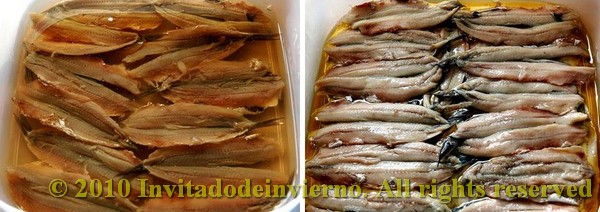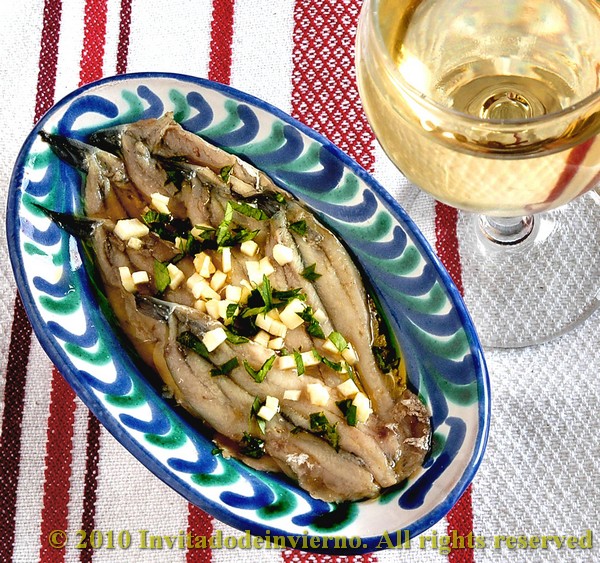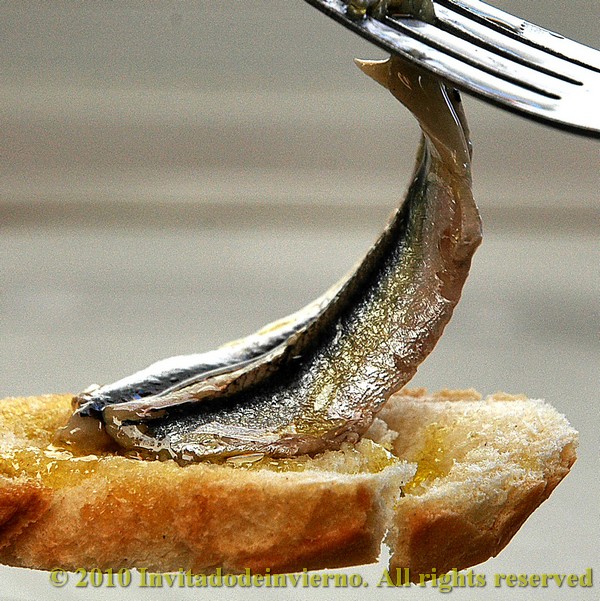Marinated anchovies or boquerones en vinagre, the ubiquitous tapa
>> Tuesday, January 26, 2010

Boquerones en vinagre, meaning fresh anchovies in vinegar, is one of the most typical and easy to make tapas in Spain and one that can be found almost everywhere. I've loved these small fish ever since I was little, and they always remind me of the beer-garlic-olive oil smell in Spanish tabernas. The fish is cured in vinegar for a short time, which gives it a whitish colour and firm consistency, and then left to rest in oil. In Spanish bars they are served in a tiny boat-shaped dish, sprinkled with minced raw garlic and chopped parsley. Either on a slice of bread or on their own... they're delicious.
This kind of marinated fish doesn't feel like raw fish at all, at least not for me. I must say that I usually hate marinated fish, for example marinated salmon, in spite of me being a salmon lover. Marinated salmon feels like raw fish to me, while I don't feel the same about the smoked variety... weird, isn't it?
I've followed the detailed step-by-step recipe of the Spanish web Pepekitchen (in Spanish...). I will try to give you as detailed an account as Pepe does. The method is easy, but you need to follow it closely, please don't improvise because if you for example marinate the fish too long you could end up with a flabby mess.
Boquerones en vinagre (adapted from Pepekitchen)
If you can't find degutted and deboned fresh anchovies, you've got to do it yourself... I have never done it myself, I could... vomit. I usually find a fishmonger to do it for me. Or my mother. Right. The photo sequence at Pepekitchen shows you how to do it: you insert your thumb nail on top of the fish head, break off the head, open the belly with your fingers and pull to extract the guts. Yeah, messy. You have to extract the backbone too, but breaking it off to just leave intact the last piece of tail, with both butterflied fillets attached to it. No, it's not as difficult as it seems. Next you have to wash the fish really well in cold water to extract all the blood. This is an important step for good results. Until a reasonable level of bloodlessness is reached, no need to dissolve the fish in the water...
Perfect, now you have a bunch of beautiful beheaded, degutted, deboned, dead, silver little anchovies... Now comes the easy part. Measure the vinegar and the water, mix and add the salt to dissolve. Lay the fish in a plastic container, skin side down, in layers. Add the marinade and lightly tap the bottom of the container for the marinade liquid to fill all the gaps. Cover with a lid and put in the fridge to marinate for 2 hours.
After that time, you'll notice the colour of the fish has changed. Check that all the anchovies have turned whitish all over, that there are no raw portions. If the fish don't look wholly cured, keep marinating somewhat longer. When the curing is done, discard the marinade liquid. Place the anchovies in another container without hardly draining them, again in layers, and finish off each layer by covering it with virgin olive oil. In the fridge they keep longer than one week. You can freeze the fish for at least 24 hours at this stage in case they were completely fresh, to make sure you kill any anisakis (at least that's what we're told to do here in Spain). I didn't freeze them because my anchovies were originally kindly frozen by my mother, who this time bought them for me.
Whenever you wish to serve the boquerones, mince or finely chop one or more peeled cloves of garlic (according to taste), chop a couple sprigs of parsley, and sprinkle on the anchovy fillets, nicely arranged on a plate. Or make a flavorful pincho by placing a couple of fillets on a Piquillo pepper. It's very usual to eat them on their own as an appetizer, soaking the dripping juices by resting each boquerón for a second on a slice of bread held on your left hand (if you're right-handed, that's understood). Enjoy on a sunny day with a beer or a glass of chilled manzanilla, though some will tell you that vinegar and wine are not a good match... I don't care.
















9 comentarios:
I have recently overcome what I thought was a dislike for anchovies ... turns out we just didn't understand one another! I actually like them, though I could never love them as much as Poppa Trix - he inhales them practically! So this is something I would definitely try. How long do you have to freeze them to kill any anisakis? That is something you do NOT want to get for sure, ew!
Wow, I love all kinds of marinated fish, these look fabulous!
beautiful! my mouth is totally watering!
Anchovies ROCK! and this looks divine! ~Mary
I have never eaten fresh anchovies. They always scared me. I'll have to get up the courage.
I haven't exactly grown up with anchovies as you have. In fact there was never any fish at the table when I was growing up so it took me a loooong time to get used to fish in general and anchovies in particular, but lately I have sort of developed a taste for this little darlings. This does look delicious!
We made something very similar in Greece and it gave me a new appreciation for anchovies.
Hello,
I was reading your sourdough bread with rye and wine posting, and I'm in fact thinking of buying a Romertof myself. I wasn't sure if it does produce the steam needed by most sourdough breads, but your post convinced me.
I love sourdough, but am a newbie. My first one - Norwich Sourdough - turned out to be okay (considering it was my first try). If you care to read it, and then comment on how to improve it, you can visit my blog at www.sotsil.wordpress.com. It's one of my more recent posts so just scroll down.
Thanks for such an interesting post.
And BTW, I love anchovies too!
Trix: you're right, I added the freezing time to the text, it's 24 hours minimum, thanks for pointing it out!
Janice: hope you try it!
Alec: haha!
Foodo: they do!!!!
AOFP: ... mmm, it's never too late to try... ;-)
Simone: yes, taste changes...
Val: mmm, I'm sure there must be similar dishes around the Mediterranean
Sharon: I answered you at your blog! Thanks for visiting!
Post a Comment